Available with ArcGIS Pro Standard and Data Reviewer licenses.
Summary
The Find Event Gaps check finds linear referenced events that have gaps on the same route or across multiple routes throughout the date and time span of the route.
Supported workflows
ArcGIS Data Reviewer checks support multiple methods for implementing automated review of data. The following table identifies the supported implementation methods for this check:
| Attribute rule type | Supported |
|---|---|
Validation | Yes (ArcGIS Pro 3.1 and ArcGIS Enterprise11.1 or later) |
Constraint | No |
Overview
The Find Event Gaps check finds linear referenced events with gaps between events of the same category, in the same route, or across multiple routes. For example, the same categories can be two speed limit events registered on the same route that don't cover the length of the route, resulting in a gap. This check considers date and time as an important factor because everything in the linear referencing system, including routes, events, and route calibration, relies on date and time. For example, a speed limit event on a route may only be valid for a date and time period.
Note:
The Find Event Gaps check must be authored in the route's network feature class.
Industry scenarios
This check can be used in the following scenarios:
- In roadway management, a speed limit event representing 55 miles per hour (mph) needs to cover the entire measure of its corresponding route feature.
- To avoid pipeline corrosion in pipeline management, recording the measure of protective coating applied to underground assets without gaps ensures the accuracy of reporting and safety of underground features.
Examples
The following image illustrates linear error events in red that represent gaps between other events in the same route and across multiple routes.
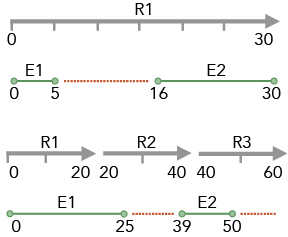
Use date filters to narrow results by time
A route represents a linear event, such as a highway, at a specific date and time. When you locate events on a route, only the events that were active during the time the route was active are displayed. The Find Event Gaps check identifies all event gaps from the time the route became active to the present time.
To avoid unnecessary results from past times, the Find Event Gaps check provides the following two filter parameters, attribute and event source filter.
Filter 1: Attribute
- Attribute—Evaluates specific routes. For example, query for routes with a RouteID that is greater than 020000000000014-D: Where RouteID is greater than 020000000000014-D.
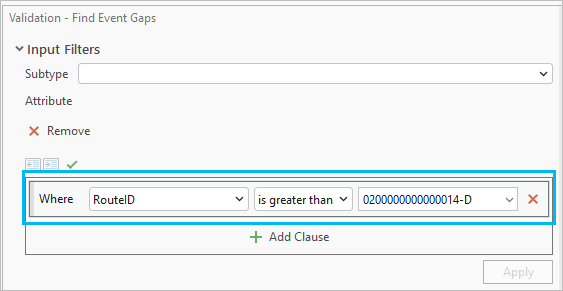
Filter 2: Event source
- Event Source—Narrows the evaluation of event gaps by a specified date. For example, query for event gaps on or after 1/1/1988: Where FROM_DATE is on or after 1/1/1988 0:00:00.
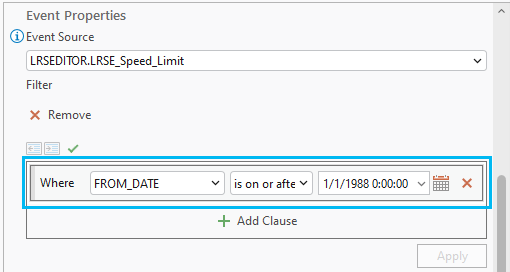
Filter scenario example
In the following example scenario, the route displayed below (highlighted in blue) has a speed limit event (highlighted in yellow) that partially overlaps with it. This overlap results in an error when using the Find Event Gaps check.
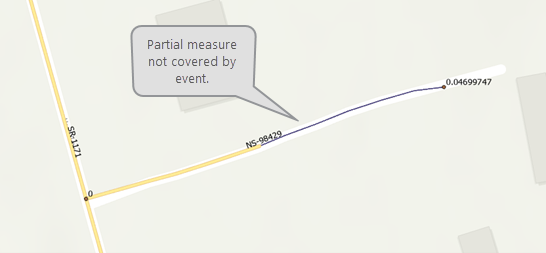
However, there is a time discrepancy between the speed limit event and the corresponding route. The speed limit event has been active since 1/1/1988, but its corresponding route has been active since 1/1/1911.
Speed limit event
| Event ID | Route ID | From measure | To Measure | From Date | To Date |
|---|---|---|---|---|---|
123 | Route 2 NS-98429 | 0 | 0.04699747 | 1/1/1988 | Present |
Using the above scenario, the following is a list of various outcomes you may encounter when using the Find Event Gaps check to identify time error overlaps.
Run the check without an event filter scenario
If you run the Find Event Gaps check without an event filter, the result is an error geometry that covers the entire length of the route. The error message lists two time slice errors:
| Error | Description |
|---|---|
Event Gap (<Event feature class name>) on (<Route feature class name>) (<ObjectID Number>) between measures 0 and 0.04699747 during the time period 1/1/1911 to 1/1/1988. | Caused by the speed limit not covering the entire length of the route from 1/1/1911 to 1/1/1988. |
between measures 0.22693 and 0.04699747 during time period 1/1/1988 to present time. | Caused by an existing speed limit event that partially covers the length of the route from 1/1/1988 to the present time. |
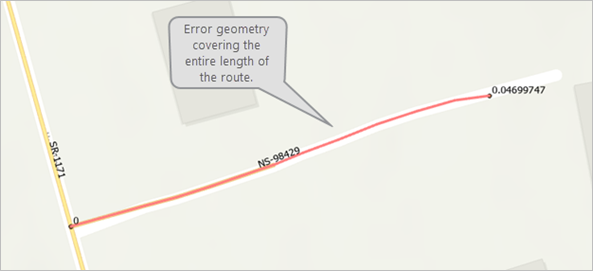
Run the check with an event filter scenario
If you run the Find Event Gaps check with an event filter on or after 1/1/1988, the check results with the following error message:Event Gap (<Event Feature class name>) on (<Route Feature class name>) (<ObjectID Number>) between measures 0.22693 and 0.04699747 during the time period of 1/1/1988 to present time.. This error is due to the event geometry that partially covers the length of the route during the specified time frame.
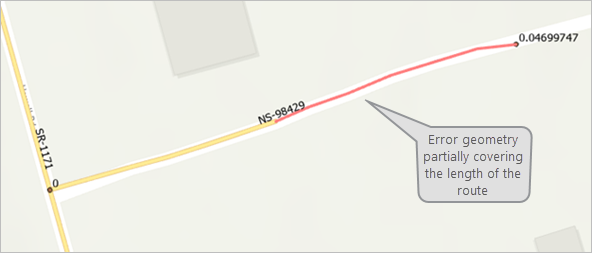
Syntax
| Parameter | Required | Explanation | Workflow |
|---|---|---|---|
Subtype | No | The subtype to which the rule is applied. | Validation |
Attribute | No | A query that can be built on the route feature to narrow down the number of routes for evaluation. Example query: Route ID is greater than or equal to 100023011 | Validation |
|
Event Properties/Route Identifier | Yes | The name of the field that contains values used to associate events to routes. The field must be a numeric data type. | Validation |
|
Route Properties/Route From Date | Yes | The name of the field that contains values that define the starting date for a route. The field must be a date data type. | Validation |
|
Route Properties/Route To Date | Yes | The name of the field that contains values that define the ending date for a route. The field must be a date data type. | Validation |
|
Event Properties/Event Source | Yes | The line event registered with the route network to be validated for gaps. | Validation |
|
Event Properties/Route Identifier | Yes | The name of the field that contains values used to associate events to routes. The field must be a numeric data type. | Validation |
Filter | No | A query that can be built on the event feature to narrow down results by time. Example query: FromDate is on or after 3/3/2010, returns gaps as errors existing on or after 3/3/2010 only. It does not return errors for gaps before 3/3/2010. | Validation |
|
Event Properties/From Measure | Yes | The name of the field that contains the starting measure value for a point or linear event feature. The field must be a numeric data type. | Validation |
|
Event Properties/To Measure | Yes | The name of the field that contains the ending measure value for a linear event feature. The field must be a numeric data type. | Validation |
|
Event Properties/Event From Date | Yes | The name of the field that contains values that define the starting date for a point or linear event feature. The field must be a date data type. | Validation |
|
Event Properties/Event To Date | Yes | The name of the field that contains values that define the ending date for a point or linear event feature. The field must be a date data type. | Validation |
|
Measure tolerance | No | Optional value used when finding event gaps based on a specific tolerance value. The linear referencing system M-tolerance is used by default. | Validation |
Name | Yes | A unique name for the rule. This information is used to support data quality requirement traceability, automated reporting, and corrective workflows. | Validation |
Description | No | A description of the error you define when a noncompliant feature is found. This information is used to provide guidance for corrective workflows. | Validation |
Severity | No | The severity of the error assigned when a noncompliant feature is found. This value indicates the importance of the error relative to other errors. Values range from 1 to 5, with 1 being the highest priority and 5 being the lowest. | Validation |
Tags | No | The tag property of the rule. This information is used in rule authoring and management workflows to support traceability and reporting of data quality requirements. | Validation |
Notes
Keep the following in mind when using the check:
- The check must be authored in the route's network feature class.
- This check supports validation of events stored in line feature classes.
- Optionally, you can define a Measure Tolerance value to use when finding events that have invalid measures. This value cannot be less than the m-tolerance value of the input route feature.
- Route features must be m-enabled and registered with the Roads and Highways or Pipeline Referencing LRS.
- This check supports validation of events that are stored in a geodatabase and registered with the ArcGIS Roads and Highways or ArcGIS Pipeline Referencing linear referencing system (LRS).
- A route identifier field (numeric data type) is required for all route and event features.
- An attribute index on the route identifier field accelerates the dynamic segmentation process.
- Events associated with
nonmonotonic route features are not evaluated by this check.
Nonmonotonic routes are routes that contain measure values that are
either continuous or do not strictly increase or decrease in
value.
The Monotonicity check is used to find nonmonotonic routes that require correction.
- Only input features with a validation status of 2 (No calculation required, validation required, no error), 3 (No calculation required, validation required, has error(s)), 6 (Calculation required, validation required, no error), or 7 (Calculation required, validation required, has error(s)) are considered during rule evaluation.
- The Attribute filter parameter is limited to comparison (=, <>, >, <, >=, and <=) and logical (AND/OR, IN/NOT IN, LIKE/NOT LIKE, and IS NULL) operators.
- The Attribute filter parameter does not support the following field types: Big Integer, Date Only, Time Only, and Timestamp Offset. If selected, the row header is marked in red and does not allow the rule to be saved.